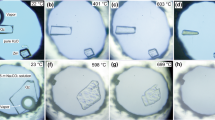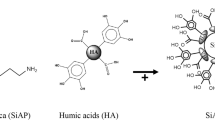Abstract
The concentrations of dissolved silica species in electrolyte solutions were derived from the relative intensities of silica species, obtained from FAB-MS measurements (fast atom bombardment mass spectrometry), and the total concentration of dissolved silica. Generally, silica species in aqueous solutions form various complexes with cations such as sodium (Na+) or calcium (Ca2+), and it has been difficult to determine the concentration of each species. From the observed results from FAB-MS, the chemical species of silica dissolved in lithium chloride (LiCl) and magnesium chloride (MgCl2) solutions do not include complexes with these cations, and thus Li+ and Mg2+ do not replace protons of the silanol groups in silica. Therefore, in LiCl and MgCl2 solutions, all of the simple structures of silicate species can be identified. The concentration of each silica species was estimated on the basis of its mass spectra peak intensities and the total concentration of silica as determined by colorimetry. This study yields the concentration of each silica species within small errors, whereas conventional methods (such as 29Si-NMR) have not yielded the concentrations of individual silica species. From these results, dimers and cyclic tetramers are concluded to be the main species in silica solutions with concentrations of at most 0.1 to 0.2 μmol⋅dm−3. This tendency should also occur in NaCl and CaCl2 solutions, which are major electrolytes in natural waters.
Similar content being viewed by others
References
Tanaka, M., Takahashi, K.: The identification of chemical species of silica in sodium hydroxide, potassium hydroxide and sodium chloride solutions by FAB-MS. Anal. Sci. 15, 1241–1250 (1999)
Tanaka, M., Takahashi, K.: Characterization of silica dissolved with sodium chloride solution using fast atomic bombardment mass spectrometry. J. Mass Spectrom. 35, 853–859 (2000)
Tanaka, M., Takahashi, K.: The identification and characterization of silicate complexes in calcium chloride solution using FAB-MS. Anal. Chim. Acta 411, 109–119 (2000)
Tanaka, M., Takahashi, K.: Determination of the changes of the basic structures of silica species in dependence on the concentration of sodium chloride by FAB-MS. Fresenius Z. Anal. Chem. 368, 786–790 (2000)
Tanaka, M., Takahashi, K.: Silicate species in high pH solution molybdate, whose silica concentration is determined by colorimetry. Anal. Chim. Acta 429, 117–123 (2001)
Tanaka, M., Takahashi, K.: Main species of silica dissolved in calcium chloride solution and their chemical implications for silica species in sodium chloride solution. J. Trace Microprobe Tech. 19, 581–589 (2001)
Tanaka, M., Takahashi, K.: Characterization of silicate monomer with sodium, calcium and strontium but not with lithium and magnesium ions by FAB-MS. J. Mass Spectrom. 37, 623–630 (2002)
Tanaka, M., Takahashi, K.: Changes of silica species in sodium chloride solution by fast atom bombardment mass spectrometry silicate complex substituted by sodium ion. J. Trace Microprobe Tech. 21, 561–575 (2003)
Tanaka, M., Takahashi, K., Sahoo, Y.V.: Dissolved silicate behavior with cations from chemical speciation in hydrologic system of arid lands for the case in N.W. China. Anal. Bioanal. Chem. 378, 789–797 (2004)
Tanaka, M., Takahashi, K.: Identification of chemical species of silica in natural hot spring water using fast atom-bombardment mass spectrometry. Instr. Sci. Technol. 33, 47–50 (2005)
Tanaka, M., Takahashi, K.: Characterization of silicate complexes in aqueous sodium sulfate solution by FAB-MS. J. Solution Chem. 34, 617–630 (2005)
Tanaka, M., Takahashi, K.: Study on salting-out effect using silica species by FAB-MS. J. Solution Chem. 36, 27–37 (2007)
Tanaka, M., Takahashi, K.: The chemical behavior of silica in water in saline area; comparison for region and evaporation process. Spectrochim. Acta, Part A 68, 21–28 (2007)
Wijnen, P.W.J.G., Beelen, T.P.M., De Haan, J.W., Van De Ven, L.J.M., Van Santen, R.A.: The structure direct effect of cations in aqueous silicate solutions. A 29Si-NMR study. Colloids Surf. 45, 255–268 (1990)
Harris, R.K., Kight, C.T.: Silicon-29 nuclear magnetic resonance studies of aqueous silicate solutions. Part 5. J. Chem. Soc., Faraday Trans. 2 79, 1525–1538 (1983)
Harris, R.K., Kight, C.T.: Silicon-29 nuclear magnetic resonance studies of aqueous silicate solutions. Part 6. J. Chem. Soc., Faraday Trans. 2 79, 1539–1561 (1983)
Smith, R.M., Martell, A.E.: Critical Stability Constants, vol. 4, p. 39. Plenum, New York (1976)
Author information
Authors and Affiliations
Corresponding author
Rights and permissions
About this article
Cite this article
Tanaka, M., Takahashi, K. Estimation of Silica Species’ Concentrations in Lithium and Magnesium Chloride Solutions from the Peak Intensities Observed by FAB-MS. J Solution Chem 37, 1187–1195 (2008). https://doi.org/10.1007/s10953-008-9295-x
Received:
Accepted:
Published:
Issue Date:
DOI: https://doi.org/10.1007/s10953-008-9295-x




